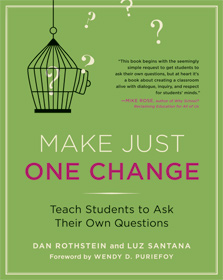This is a guest post by Esther Lee.
Bullying has been a serious issue in and out of schools for decades, yet it has recently become a hot topic of interest for parents and teachers both in schools and in media. How come?
It seems that the types of bullying that we are aware of as adults are quite different from the bullying that kids experience today. One obvious reason is the surfacing of cyber–bullying. This is an aspect of bullying that we never experienced ourselves – it evolves from the social media that kids maneuver through everyday without parents’ supervision. So the question is: What are effective ways of teaching children about the types of bullying that specifically occur today? What problems do we face in teaching these new concepts when we are personally inexperienced with cyber-bullying? How can we abolish bullying once and for all?
It wasn’t until a couple of months ago when I started writing about the community building and engagement aspects of using the Question Formulation Technique that I began to wonder about why I had not used the QFT to teach the mandated anti-bullying unit. The QFT clearly had positive effects on students’ social-emotional growth, but in retrospect, I was afraid to use a student-driven formula for a sensitive topic, afraid that students would take the discussion into different directions.
According to the Department of Education, 46 states now have anti-bullying laws in place. Even the federal government noticed the urgency of this issue and developed its own website through the Department of Health and Human Services. There are many other resources out there now to help parents and teachers help promote anti-bullying ideas, yet bullying continues to be prevalent in most U.S. schools.
Many of the suggested anti-bullying strategies are directions for kids or teachers, such as: “Encourage kids to speak to a trusted adult…” “Talk about how to stand up to kids who bully,” “talk about strategies…” “Urge them to help kids who are bullied.” These frequently used tactics do not allow students to think deeply about the important ideas such as why or when bullying occurs, and how kids have the power to change the situation. It would be better if we left room for kids to think for themselves. I have seen just how quickly students can learn to do that when they have the chance to ask questions.
Teacher questions during an anti-bullying unit narrowly consist of: “What does ‘bullying’ mean to you?” “Why do you think people bully?” “What do you think parents can do to help stop bullying?” “What do you usually do when you see bullying going on?” “Have you or your friends left other kids out on purpose?” (Stopbullying.gov). These questions, meant to provoke thinking, too often leave students trying to guess what the teacher wants to hear as an answer to the questions.
Even in the well-known documentary, Bully, the camera crew follows different individuals getting bullied and interviews each child, but nowhere in the documentary is there an adult figure who solves the bullied child’s problems. In fact, the documentary showed that children seldom open up to adults; they feel helplessly misunderstood when speaking with adults who try to support them. These children rely on their own instincts, and those who are lucky enough, rely on their peers, to fight through the struggles.
Bullying is a complex problem involving ethics and social interactions, which stems from deep-rooted problems from both the bully and the bullied. Empathy is key when addressing this issue, yet as adults, we blindly transfer our knowledge of bullying concepts to our kids. If today’s children are getting bullied in different ways and in different environments than we are used to as adults, isn’t it logical for us to gear our anti-bullying education towards their ideas, suggestions, and questions; not towards our own outdated experiences from years ago? The QFT could help kids develop their own questions, assess and think about their questions, and allow them to answer self-produced questions about bullying so that every step of the lesson is child-centered and student-driven. The QFT has a rigorous structure that provides a judgment-free zone, which leads students to open up their thinking and ask as many questions as possible. They then willingly join the activity, feeling less vulnerable and a stronger connection to the topic.
Bullying was an ongoing problem in my school, especially in my classroom among the students with emotional disturbance. Instead of having the students answer to my questions and listen to my suggestions about bullying, the students should have developed the lessons for themselves and that could have happened more easily had they started off by asking their own questions.
If I were to lead an anti-bullying unit now, I would develop some Question Focus examples that serve as the catalyst for student questions. I might use a real-life photo, a drawn image, or a photo specifically depicting cyber-bullying. Since these images are powerful, I imagine students coming up with powerful questions (i.e. “Why is he just standing there?” “How old are they?” “Why is she doing that?” “Why is the kid crying?” etc.) Even if students come up with the standard questions we as teachers ask in anti-bullying lessons, there is a significant cognitive and affective difference when students are formulating their own questions. Students will take more ownership and realize that they are a lot more knowledgeable about the topic than adults believe them to be. Following the steps of the QFT by categorizing and prioritizing their questions will aid students to think about what aspects of bullying are truly important and what questions are valuable in solving this issue once and for all.
I encourage all teachers to try use the QFT as part of their anti-bullying work. This would create refreshing, real student-driven anti-bullying efforts. Please share your experiences with our online Educator Network, and let others know how students react to an anti-bullying lesson grounded in their own questions – a true example of Inquiry-Based Learning. We all could learn more about the bullying challenges students face today if we base the lessons less on some of our outdated notions of bullying and more on the questions students themselves are raising.





Another thought provoking post! Agreed the ongoing prevalence of bullying requires alternative methods of exposing children to the effects, QFT indeed may be effective
Such a thought provoking idea. Our district does not a unit for anti-bullying but our grade level does work around these issues during October when it’s anti-bullying month. Food for thought for next year. Thanks for sharing.
@mgz423 Sounds like a great idea